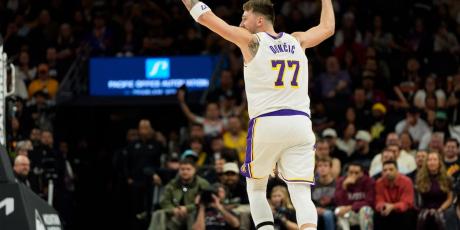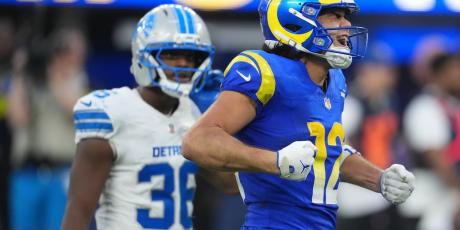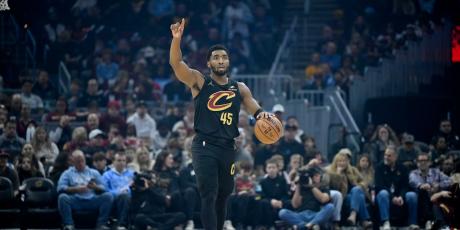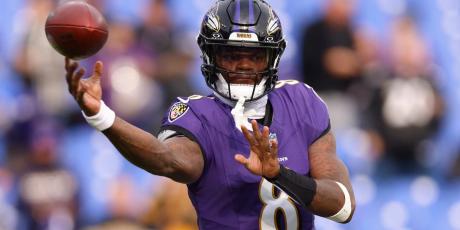Yahoo DFS GPPs: A 2019 Review

Each week, Yahoo features the Baller as the biggest NFL DFS tournament on the main slate. A review of winning lineups from this tournament can show how those players constructed their lineups—in terms of percentage of lineups that players were rostered, salaries and stacking techniques—and tease out profitable DFS strategies.
Winning Roster Construction - Rostered Percentage
Understanding how to balance popular players with contrarian picks is the foundation of being a profitable DFS tournament player. The following table shows rostered percentages for every winning Baller lineup from 2019:
| Week | QB | RB1 | RB2 | WR1 | WR2 | WR3 | TE | Flex | RB or WR Flex? | DEF | Average |
|---|---|---|---|---|---|---|---|---|---|---|---|
| 1 | 7.9 | 22.4 | 10.5 | 9.5 | 4.7 | 3.6 | 2.2 | 0.9 | RB | 8.7 | 7.8 |
| 2 | 20.1 | 6.7 | 4.4 | 6.1 | 4.1 | 3.6 | 7.4 | 3.4 | WR | 8.2 | 7.1 |
| 3 | 1.6 | 6.6 | 3.2 | 10.0 | 7.6 | 4.8 | 4.8 | 3.7 | WR | 7.6 | 5.5 |
| 4 | 1.4 | 36.8 | 17.1 | 12.7 | 8.6 | 1.6 | 3.5 | 11.9 | RB | 1.6 | 10.6 |
| 5 | 12.0 | 28.1 | 7.7 | 28.3 | 23.7 | 22.4 | 22.2 | 6.2 | RB | 19.6 | 18.9 |
| 6 | 32.5 | 16.3 | 12.8 | 18.2 | 13.5 | 7.2 | 2.4 | 4.4 | RB | 18.8 | 14.0 |
| 7 | 1.9 | 24.3 | 20.4 | 13.2 | 10.4 | 2.5 | 22.8 | 5.0 | RB | 30.7 | 14.6 |
| 8 | 4.2 | 56.0 | 17.1 | 19.9 | 7.6 | 5.3 | 8.4 | 2.2 | RB | 13.6 | 14.9 |
| 9 | 11.9 | 16.0 | 13.2 | 18.8 | 16.1 | 14.6 | 1.2 | 3.0 | RB | 5.9 | 11.2 |
| 10 | 10.3 | 30.4 | 10.9 | 32.5 | 13.4 | 14.2 | 5.2 | 2.6 | RB | 46.1 | 18.4 |
| 11 | 9.2 | 35.2 | 3.4 | 13.6 | 9.2 | 8.7 | 10.6 | 0.6 | WR | 13.8 | 11.6 |
| 12 | 4.2 | 24.3 | 22.7 | 6.2 | 3.1 | 1.6 | 14.5 | 19.8 | RB | 5.0 | 11.3 |
| 13 | 7.2 | 59.6 | 40.7 | 21.7 | 14.1 | 10.8 | 14.0 | 12.2 | RB | 5.3 | 20.6 |
| 14 | 1.8 | 20.6 | 7.1 | 14.8 | 9.2 | 7.8 | 3.8 | 3.7 | RB | 39.7 | 12.1 |
| 15 | 5.9 | 13.3 | 7.6 | 16.6 | 5.9 | 4.0 | 0.4 | 3.0 | RB | 3.5 | 6.7 |
| 16 | 8.4 | 34.5 | 16.9 | 22.0 | 21.6 | 5.8 | 3.5 | 10.6 | RB | 3.8 | 14.1 |
| 17 | 7.4 | 33.7 | 11.3 | 28.0 | 19.7 | 6.0 | 43.4 | 9.9 | RB | 2.3 | 18.0 |
| AVG | 8.7 | 27.3 | 13.4 | 17.2 | 11.3 | 7.3 | 10.0 | 6.1 | 13.8 | 12.8 |
Click headers to sort.
While it might seem intuitive that a lineup has to have a roster full of unpopular players to best a field of tens of thousands of opponents, the data shows that being unique with just a couple of roster spots can be enough to separate yourself from the competition. On average, winning Baller lineups contained just three players in fewer than 10% of lineups.
Reviewing position-by-position rostered percentages offers a more granular analysis of how winning lineups balanced chalk with contrarian plays.
Quarterbacks
In traditional redraft leagues, it’s understood that quarterback scoring is largely replaceable and fantasy managers can usually wait until the end of their drafts to fill that position. That lesson translates to DFS, even in contests with top-heavy prize structures. Bottom- and mid-tier passers can, and do, match the weekly production of their elite counterparts on a regular basis.
In fact, Baller winners had more success going against the grain than with the crowd at quarterback—12 winners used a sub-10% quarterback and six had a signal-caller rostered in fewer than 5% of lineups, while only two winning lineups used a quarterback rostered in at least 15% of lineups. Of course, there are far more quarterbacks drawing low rostered percentages than those near the 20% mark, but that’s kind of the point. Building an unpopular stack around a solid core of players is often a profitable plan.
Running Backs
Yahoo’s half-PPR scoring lends itself to a running back-centric approach to lineup construction and that doesn’t change much in large-field contests. Because running backs touch the ball more than any player besides the quarterback, they are the most predictable position in fantasy other than quarterback.
The difference is that top running backs score much more than mid-tier backs, while quarterback scoring is generally flat. With that, it makes sense that Baller winners rarely used an overly-contrarian strategy when picking running backs—just eight RB1s or RB2s in winning lineups showed up in fewer than 10% of lineups. This isn’t to say that there isn’t room to be creative with your running backs, which will be shown when examining the Flex.
Wide Receivers
Even the top wide receivers in the league see relatively low volume compared to running backs. That low volume leads to volatile weeks, allowing DFS players to fade public opinion when choosing which receivers to roster. Of the 31 players to show up in at least 20% of winning Baller lineups, just eight were wide receivers and there were only three instances where a receiver on a winning roster was in over a quarter of lineups.
The middle tier of rostered percentage was the sweet spot for wide receivers. WR1s and WR2s in winning lineups both saw average rostered percentages in the double digits and only three WR1s were rostered in fewer than 10% of lineups. Having at least one contrarian pick at wide receiver was often enough to differentiate from the field.
Tight Ends
Tight end has traditionally been a position in DFS where it makes sense to be contrarian—the position sees less volume than any of the other skill positions and there are usually only two or three really popular tight end plays. Consequently, the chance of the chalk busting is usually quite high. While a couple of mega-chalk tight ends hitting in 2019 certainly drove up the average rostered percentage seen above, there were still 11 tight ends on winning teams that were on fewer than 10% of rosters and eight with a sub-5% rostered rate. With a crop of young talent at the position, 2020 may see an even more contrarian winning approach at the position.
Flex
Before getting into this analysis, it should be noted that for this study, the flex was defined as the RB3 or WR4 with the lowest rostered percentage in a lineup—labeling a Christian McCaffrey who is in 40% of lineups, for example, as the flex just because he was technically rostered there makes little sense.
As mentioned earlier, Yahoo scoring is tailored to favor running backs and that’s most evident when examining the flex position in winning Baller lineups—14 of 17 winners opted for a running back as their flex. Compared to RB1s or RB2s, though, running backs used in the flex were usually unpopular picks. This is where fantasy managers can embrace volatility and bet on unlikely outcomes—running backs that are workhorses but are slight underdogs or backs in a committee situation on a team with favorable running back circumstances are perfect candidates to complement two popular, highly-predictable players at the position.
As for extra pass-catchers, it’s almost never a good play to roll out four relatively popular wide receivers in these types of contests. A two-tight end strategy should be used sparingly, if at all.
Defense
Defense, like quarterbacks, is a position that isn’t flex-eligible with generally flat scoring and flat rostered percentages. Limiting your player pool to defenses that will be ahead, especially against teams that already throw a lot, is a fine strategy. Not shying away from games that might be high scoring is a sneaky way to be contrarian since high point totals often involve defense and special teams scores. These premises are relatively well known which is why a completely off-the-wall defense is rarely worth rostering.
Winning Roster Construction - Salary
Note that designations such as RB1 and WR1 in this section refer to the highest-salaried player at the position on each roster. Consequently, the RB1 in terms of salary may not necessarily match up with the RB1 in terms of percentage rostered above.
| Week | QB | RB1 | RB2 | WR1 | WR2 | WR3 | TE | Flex | RB or WR Flex? | DEF | Total |
|---|---|---|---|---|---|---|---|---|---|---|---|
| 1 | $39 | $37 | $25 | $22 | $15 | $13 | $16 | $18 | RB | $14 | $199 |
| 2 | $31 | $30 | $28 | $21 | $19 | $17 | $16 | $16 | WR | $22 | $200 |
| 3 | $32 | $31 | $19 | $30 | $20 | $14 | $16 | $13 | WR | $25 | $200 |
| 4 | $25 | $38 | $31 | $23 | $19 | $16 | $17 | $20 | RB | $11 | $200 |
| 5 | $35 | $38 | $24 | $24 | $14 | $10 | $20 | $20 | RB | $15 | $200 |
| 6 | $26 | $33 | $27 | $33 | $21 | $20 | $12 | $18 | RB | $10 | $200 |
| 7 | $27 | $40 | $35 | $20 | $16 | $12 | $18 | $12 | RB | $20 | $200 |
| 8 | $21 | $37 | $19 | $29 | $25 | $17 | $22 | $18 | RB | $12 | $200 |
| 9 | $38 | $24 | $20 | $30 | $28 | $18 | $13 | $19 | RB | $10 | $200 |
| 10 | $40 | $41 | $23 | $19 | $16 | $16 | $21 | $10 | RB | $13 | $199 |
| 11 | $30 | $41 | $22 | $22 | $19 | $17 | $22 | $12 | WR | $15 | $200 |
| 12 | $33 | $40 | $23 | $32 | $16 | $14 | $12 | $20 | RB | $10 | $200 |
| 13 | $31 | $42 | $30 | $22 | $18 | $18 | $10 | $16 | RB | $13 | $200 |
| 14 | $28 | $30 | $23 | $35 | $19 | $18 | $14 | $18 | RB | $12 | $197 |
| 15 | $33 | $32 | $17 | $33 | $30 | $12 | $11 | $15 | RB | $17 | $200 |
| 16 | $26 | $25 | $17 | $38 | $24 | $23 | $15 | $16 | RB | $16 | $200 |
| 17 | $34 | $34 | $25 | $31 | $22 | $11 | $18 | $15 | RB | $10 | $200 |
| AVG | $31 | $35 | $24 | $27 | $20 | $16 | $16 | $16 | $14 | $200 |
Click headers to sort.
Many of the takeaways from deconstructing winning salaries will match what we saw at the positional level with rostered percentages but there are still specifics to roster salaries worth exploring. When we zoom out to the team level, we see that leaving salary on the table hasn’t proven to be a winning strategy in the Baller—only one winner left more than $1 to spend and 14 winners used the entire $200 salary cap. However, results could be skewed if the overwhelming majority of users are using most of the salary by default—in other words, there may not be enough users experimenting with leaving substantial salary on the table to know if it can be a viable strategy.
Quarterbacks
Evidence of quarterback scoring being replaceable is apparent with salaries just as it is in rostered percentages or in redraft leagues. The average salary of a quarterback on winning Baller rosters ($31) represented one roughly in the QB10–QB12 range, depending on the week. With quarterbacks salaries as high as $40 and as low as $21, we see that it’s more important to find a quarterback that will be part of an unpopular stack in a favorable situation than it is to focus on a specific salary tier.
Running Backs
The highest-salaried running backs in any given week are bellcows that have dominated in fantasy in recent games who are in favorable situations—usually big favorites—so it’s no surprise that most winning lineups contained at least one relatively expensive back. The valuable takeaway is that while Baller winners usually had two relatively popular backs—as mentioned in the rostered percentage discussion—the second back was usually quite affordable.
This speaks to the fact that running back production is more predictable than most other positions. Backs that hadn’t played well in recent weeks or hadn’t been given a large touch share to that point will naturally have depressed salaries but fantasy managers have still been successful at pinpointing which of these players were in a situation to have a big fantasy game.
Wide Receivers
Wide receivers with salaries in the middle and low tiers have been the most popular options in winning GPP lineups on Yahoo. Of the 54 receivers used by winners last season, just nine carried salaries at or above $30, a range usually reserved for those in the top five or six at their position.
This is a bit of a chicken or egg scenario. High-salary, multi-use backs have dominated scoring in recent years—prioritizing those players leaves fewer opportunities to spend up at other positions. On the other hand, even the most voluminous receivers usually see fewer than 10 touches in a game so it stands to reason that paying down at the position and embracing the inherent volatility of pass-catchers is a profitable strategy.
Top-end wide receivers shouldn’t automatically be eliminated from your player pool but there is plenty of evidence to suggest that loading up on multiple high-salary receivers and foregoing at least one elite-tier running back usually isn’t going to reach the top of the leaderboards on Yahoo.
Tight Ends
In theory, tight end should be the least predictable position since they see the least volume on offense. Comparing tight end rostered percentages to salaries in winning lineups upholds this notion. The average salary of tight ends on winning rosters ($16) usually comes in somewhere in the TE10–TE12 range. This means that most winners are rostering a tight end with the salary of a fantasy starter but few correctly predict which tight end would actually have a big game. While punting this position can be viable in cash games, tight ends with salaries outside the top 20 rarely have enough upside to carry a team to the top of a large tournament.
Flex
With salary restrictions, it’s obvious that the last position player is the cheapest but there are some subtleties to notice when looking at flex pricing. Winners spent at least $20 on their flex spot just three times last year, suggesting that some version of a stars-and-scrubs approach trumps a balanced salary build in GPPs.
Every winning lineup in 2019 had at least one player with a salary of $30 or more and only five of the 17 winners rostered a team without a player that was at least $35. This stars-and-scrubs approach, however, was rarely taken to the extreme as just four winners had a flex player with a salary below $15.
Defense
Defense saw a relatively smooth salary curve amongst winners. When possible, defense is a position that winning DFS players have traditionally looked to punt but 2019 saw a disproportionate number of large spreads, leading to increased usage on high-salary defenses. If there are fewer games with spreads of 10-plus points in 2020, the average salary at the position could quickly fall even lower than it was last season.
Winning Roster Construction - Stacking
No matter how winning DFS players built their teams in terms of rostered percentages and salaries, one strategy remained constant: stacking. For those unfamiliar with the term, stacking means pairing multiple players from the same team or in the same game. This can be done to increase lineup volatility, which, in turn, increases a lineup’s ceiling. To increase volatility, you would stack multiple players from the same team that are dependent on one another. The most common stack is a QB with at least one of his receivers—if the QB goes off, it’s likely his receivers will as well.
Stacks Used in Winning Lineups
In 2019, 16 of 17 Baller winners stacked their quarterback with at least one other player from the same offense. The only winner not to do so still added some correlation, rostering a wide receiver from his quarterback’s opponent. Additionally, 10 winners had at least three players from one offense and eight of those included a player from the opposing offense.
The stacking didn’t stop there. In addition to stacking with a quarterback, 10 winners added a second pair of players from the same game. After all of the winning data was accounted for, every winner except for one rostered three or more players with some sort of in-game correlation. Building as much correlation as possible into your lineups will offer much higher odds at having a big score in a GPP than throwing darts at a bunch of unpopular individuals.
4for4’s Pat James explains it best in his weekly stacks column:
“I like building contrarian stacks around my chalkier core of players because you only have to get one [or two] instances correct...to hit. For example, if we hit on a contrarian quarterback play while having a pass-catcher or two from that same game, the positive correlation of those stacks is technically getting one contrarian play correct despite filling multiple roster slots...this is easier than having a chalkier stack while trying to hit multiple individual [unpopular] plays throughout the rest of your lineup. Keep in mind that [when using] these contrarian stacks, you don’t have to use [them] in a large percentage of lineups to be overweight on the field...”
How to Find Winning Stacks
Stacks almost always start with quarterbacks but as explained with rostered percentages and salaries, going straight to the top isn’t always a winning strategy. Those high-salary quarterbacks are usually on offenses that are the biggest favorites and, more importantly, carry the highest implied team totals.
What we see with winning stacks, though, is that you don’t always have to target the offenses that are projected to score the most points. To illustrate that point, consider the betting totals for each quarterback’s offense from 2019 winning Baller lineups:
| Week | Team Spread | Team Implied Total | Game O/U |
|---|---|---|---|
| 1 | -3.5 | 26.25 | 49.0 |
| 2 | -13.0 | 29.50 | 46.0 |
| 3 | 11.0 | 24.50 | 44.0 |
| 4 | 9.0 | 19.75 | 48.5 |
| 5 | -4.0 | 26.50 | 49.0 |
| 6 | 3.0 | 24.75 | 52.5 |
| 7 | -2.5 | 23.00 | 43.5 |
| 8 | 6.5 | 21.25 | 49.0 |
| 9 | -4.0 | 27.50 | 51.0 |
| 10 | -10.5 | 27.25 | 44.0 |
| 11 | -7.0 | 24.25 | 41.5 |
| 12 | 3.5 | 24.00 | 51.5 |
| 13 | -10.5 | 27.75 | 45.0 |
| 14 | -1.0 | 23.00 | 45.0 |
| 15 | -5.5 | 25.75 | 46.0 |
| 16 | 1.5 | 22.25 | 46.0 |
| 17 | -12.5 | 30.00 | 47.5 |
| AVG | -2.3 | 25.10 | 47.0 |
Click headers to sort.
The average offense of a winning stack is a moderate favorite with a high, but not astronomical, implied point total. It should be noted that there seem to be some clear minimum thresholds in regards to using betting lines to pick offenses to stack in tournaments. Only five quarterbacks in winning lineups were on teams with implied point totals below 24 and just three were on teams that were underdogs of four or more points.
Note that those teams with low implied totals or that were big underdogs were often in games with high over/unders. Passing games are typically very highly correlated so if one offense is expected to blow up in a given week and have high rostered percentages, it can often be a profitable strategy to build a handful of lineups with players in the opposing passing game.
Recap of Winning Trends
- Quarterback scoring is flat and replaceable. Balance your GPP portfolio with high-salary, popular plays and cheap, contrarian plays. The same stands for defense, although a shift may be coming for the latter if there are closer spreads in 2020.
- Be willing to pay up at running back, as Yahoo’s scoring system favors the position. Winning GPP players are often forcing a third mid-salary, but unpopular, running back in the flex.
- Winning GPP lineups rarely featured a wide receiver with a top-six option salary at the position but also tended to steer clear of players with a salary all the way at the bottom
- The pool of usable tight ends was small last season. If even a few players emerge as viable options early in the season, tight end could be an exploitable position before owners adjust.
- Stacking is a virtual must to take down a tournament and the best strategy is to have multiple correlations built into one lineup. Teams don’t always have to be the highest-scoring of the week but they should at least be opposite a high-powered offense


















